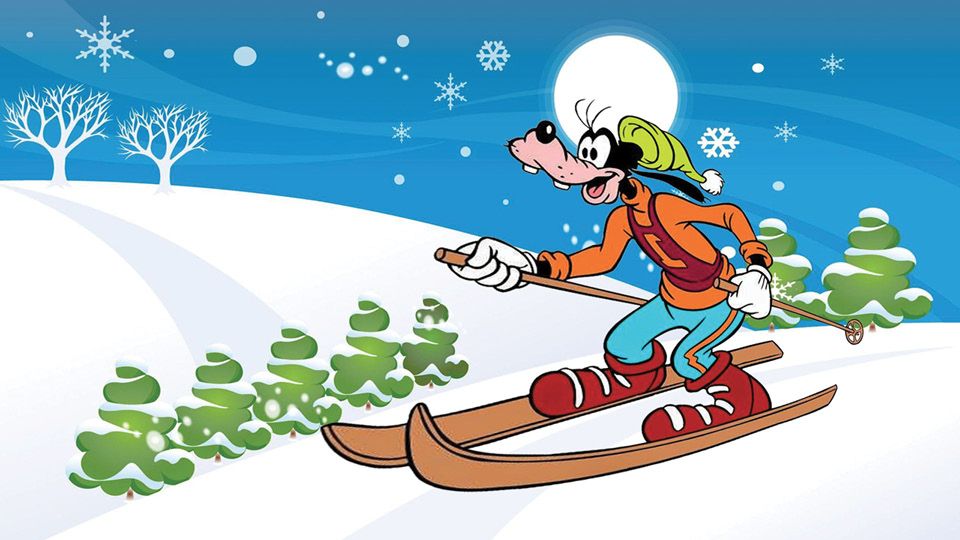
SKIING HISTORY
Editor Kathleen James
Art Director Edna Baker
Contributing Editor Greg Ditrinco
ISHA Website Editor Seth Masia
Editorial Board
Seth Masia, Chairman
John Allen, Andy Bigford, John Caldwell, Jeremy Davis, Kirby Gilbert, Paul Hooge, Jeff Leich, Bob Soden, Ingrid Wicken
Founding Editors
Morten Lund, Glenn Parkinson
To preserve skiing history and to increase awareness of the sport’s heritage
ISHA Founder
Mason Beekley, 1927–2001
ISHA Board of Directors
John Fry (1930-2020), Chairman
Seth Masia, President
Wini Jones, Vice President
Jeff Blumenfeld, Vice President
John McMurtry, Vice President
Chan Morgan, Treasurer
Einar Sunde, Secretary
Richard Allen, Skip Beitzel, Michael Calderone, Christin Cooper, Art Currier, Dick Cutler, Chris Diamond, David Ingemie, Rick Moulton, Wilbur Rice, Charles Sanders, Bob Soden (Canada)
Presidential Circle
Christin Cooper, Billy Kidd, Jean-Claude Killy, Bode Miller, Doug Pfeiffer, Penny Pitou, Nancy Greene Raine
Business & Events Manager
Kathe Dillmann
P.O. Box 1064
Manchester Center VT 05255
(802) 362-1667
kathe@skiinghistory.org
Membership Services
Laurie Glover
(802) 375-1105
laurie@skiinghistory.org
Corporate Sponsorships
Peter Kirkpatrick
(541) 944-3095
peterk10950@gmail.com
Bimonthly journal and official publication of the International Skiing History Association (ISHA)
Partners: U.S. Ski and Snowboard Hall of Fame | Canadian Ski Museum and Hall of Fame
Alf Engen Ski Museum | North American Snowsports Journalists Association | Swiss Academic Ski Club
Skiing History (USPS No. 16-201, ISSN: 23293659) is published bimonthly by the International Skiing History Association, P.O. Box 1064, Manchester Center, VT 05255.
Periodicals postage paid at Manchester Center, VT and at additional mailing offices. Postmaster: Send address changes to ISHA, P.O. Box 1064, Manchester Center, VT 05255
ISHA is a 501(c)(3) public charity. EIN: 06-1347398
Written permission from the editor is required to reproduce, in any manner, the contents of Skiing History, either in full or in part.
Animators Go Looney Over Skiing
When cartoons take a run at skiing, mayhem ensues.
Goofy does not live up to his name in what might be the most realistic instructional cartoon on skiing (above). Part of Goofy’s “How To” oeuvre, The Art of Skiing shows viewers how to dress, load a chairlift and kick-turn, and even features an authentic yodeler on the soundtrack.
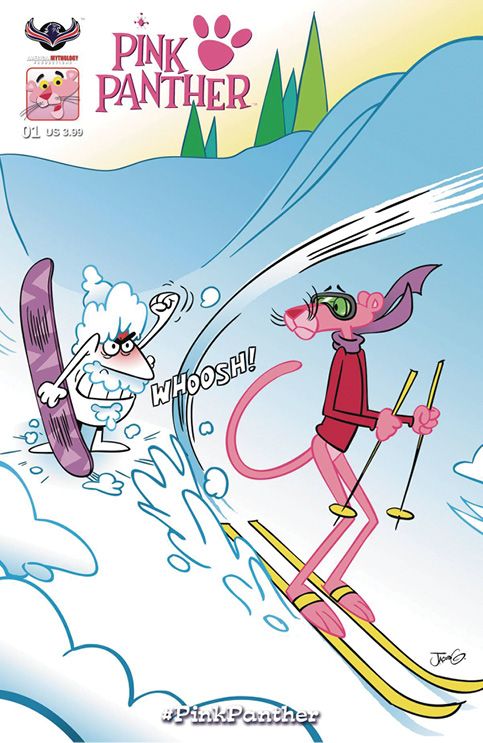
What is quickly learned from total immersion into the golden age of animation, roughly the 1930s through the 1970s, is that when Hollywood animators put characters on skis, they suspend the laws of physics. From the earliest cartoon depictions to a recent animated relaunch on HBO, skiing is primed for slapstick humor, visual punchlines and lots and lots of long freefalls.
Popeye crashes off ski jumps. Wile E. Coyote falls off cliffs with an ice machine on his back. The Pink Panther is engulfed in a giant snowball, while Homer Simpson hangs from a chair upside down and is blasted by a frigid fan gun and fiery snowcat exhaust, to name just a few.
Each stunt is more gravity-defying than the next one, often relying on a host of products, usually from the Acme Corporation, makers of sticks of dynamite, intricate booby traps, and anvils and bank safes that inevitably are dropped on unsuspecting heads.
And when viewed through 21st century goggles, some animation was so politically incorrect as to be downright cringeworthy, from Betty Boop resisting an unwanted suitor, to Tom from Tom & Jerry panting over a ski bunny, to poking fun at poor Mr. Magoo for his near-sightedness.
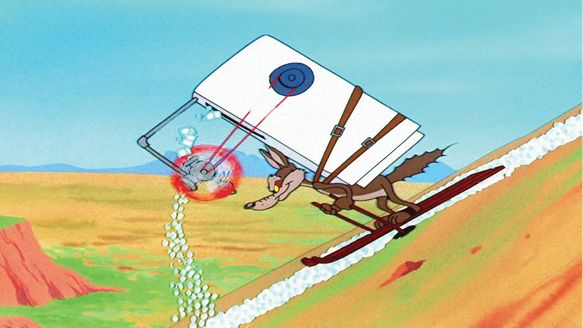
The sight gags are endless. There are drunken St. Bernards, skiers on the wooden runners of a rocking horse, a dachshund too long for a single pair of skis riding atop two pairs of them, and characters sailing off ski jumps with parachutes.
You’ll often see one of the most popular of all ski sight gags: downhill tracks on both sides of a tree, as if the cartoon character went through unharmed. (A tip of the hat to Charles Addams’ famous 1940 cartoon “The Skier” in the New Yorker that set the gold standard.) But in cartoonland, no one is seriously injured. Like a classic clown bop bag, they bounce back up for even more indignities in the next scene.
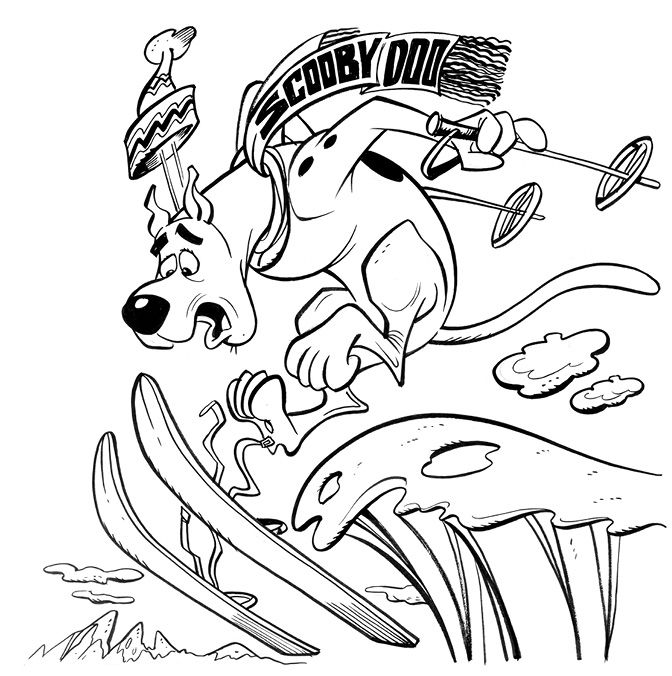
Lucille Ball broke her leg skiing while starring in a TV sitcom, and her real-world accident (and her subsequent leg cast) was famously written into that season. “But in cartoons, characters get hurt, you laugh, and you move on to the next gag,” A.B. Osborne, Professor of Animation at Georgia’s Augusta University, explains.
What is it about skiing that appeals to cartoon animators? “It’s a visual sport and people get it immediately,” Osborn says. “When someone is going down a hill on skis, you don’t have to explain it. I never went skiing in my life, but I know what it is.”
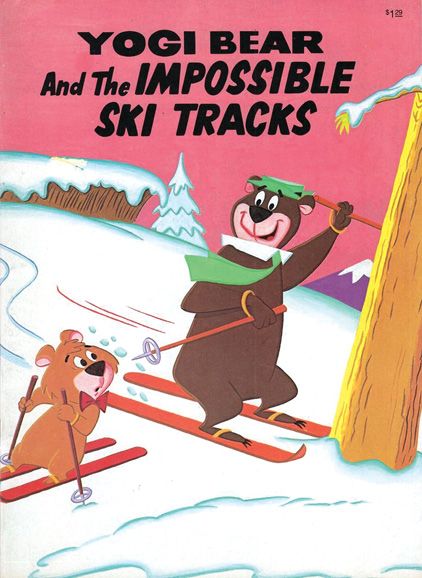
Hours viewing vintage cartoons online reveals a world where skiing was considered glamorous and a colorful theme for all manner of cold-weather comedy and conflict. Popularized in 1930 during the start of Hollywood’s golden era of animation, these short-form cartoons ran before main features, then were eventually broadcast on TV. Many were inspired by vaudeville acts such as The Three Stooges and Laurel and Hardy, according to Robert Ito writing in the New York Times (May 29, 2020).
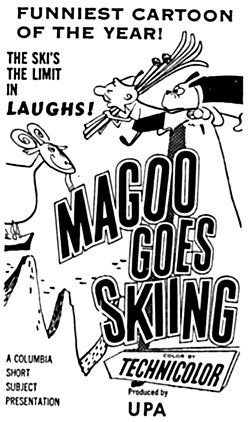
Pandemic Antidote
Watching ski cartoons from a couch is the perfect antidote to a cranky Covid-19 lockdown. According to CartoonResearch.com, the earliest references in titles to ski themes are from the Mutt and Jeff shorts. Among the 292 animated cartoons produced from 1916-1926 that depict skiing are On Ice (1918), Mutt and Jeff in Switzerland (1919), The Frozen North (1919), The Far North (1921), and Any Ice Today (1922). American cartoonist Paul Terry’s series of animated short subjects based upon Aesop’s Fables included ski scenes in On the Ice (1924), An Alpine Flapper (1926), and Cracked Ice (1927).
Those shorts are unavailable, so I wasn’t able to confirm their ski content. The earliest cartoon depiction I could confirm is Krazy Kat’s Snow Time (1932). When Krazy tries to jump in his skates over a row of barrels, he misjudges the distance and crashes into the last barrel, breaking it into slats, two of which stick to his feet as skis. He slides uncontrollably down the pond, jumping over small snow mounds. A snowman unzips his “snow” suit, revealing a skeleton inside, and tosses the snow back at Krazy, who grows into a giant snowball.
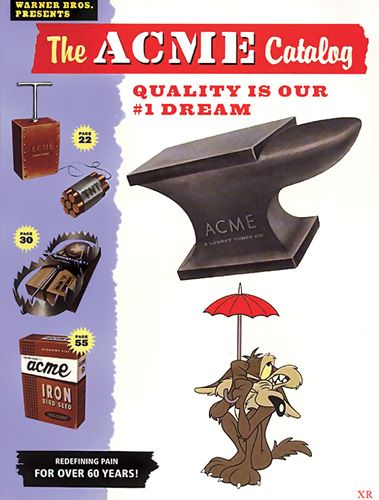
Betty Boop & Pudgy in Thrills and Chills (1938) is one of the least circulated or known of all the Betty Boop episodes. According to CartoonResearch.com, Betty tries to get on a train to the mountains, but her way is blocked by a freckle-faced male doofus who demands, “Hey pretty girl. Give me a kiss and I’ll let you in.” He then stalks her for more than six minutes. He eventually saves Betty and her dog Pudgy from peril. The dastardly interloper finally gets his kiss—from the dog. Politically correct it’s not.
Goofy’s The Art of Skiing (1941) is one of the most definitive ski cartoons in animation history. This was the first in Goofy’s acclaimed “How To” catalogue of shorts in which the character tackled a recognized sport. Walt Disney Productions animators even retained a professional yodeler to provide an authentic soundtrack.
In the cartoon, Goofy explains how to dress for the day’s activities—including devising his own challenge of putting on trousers when his feet are already in skis. Finally reaching the summit by way of a chair lift, he demonstrates a kick-turn, and how to get up when fallen. He lands backwards and skis in reverse, which, of course, eventually leads to him going off a ski jump—except Goofy forgets to lace his ski boots, which separate his skis from his feet shortly after takeoff. He manages to get hold of both of them, using the skis as glider wings to maneuver between mountain peaks, then finally crash-lands through the window of his own room at the ski lodge. Goofy falls instantly sound asleep, to close out the perfect day on the slopes.
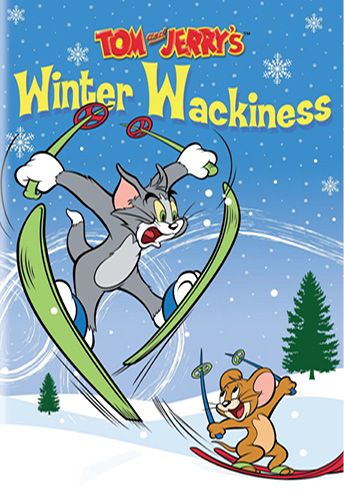
One of the cleverest of all sight gags, which channels Rube Goldberg, appears in Fast and Furry-ous (1949) a Warner Bros. Looney Tunes Road Runner cartoon that shows a resourceful Wile E. Coyote strapping a full-size refrigerator to his back, then feeding ice cubes into a meat grinder to create a strip of skiable crushed ice. It works great—until he skis off a cliff.
Back in the 1950s, any infirmity was seemingly fair game. In Magoo Goes Skiing (1954) the opening sets up a gag to follow, as the severely near-sighted Magoo calls out to a mountain peak with his best attempt at a yodel—but is disappointed to hear no echo. The fact that he’s serenading a picture on the ski lodge wall rather than a real mountain is the explanation. Magoo really intends to go skiing—but of course he picks up a St. Bernard along the way (another ski resort stereotype) whom he thinks is his nephew Waldo.
Skiing, and its alluring enthusiasts, has always offered plenty of opportunities for romantic entanglements. Incongruously, Popeye appears far from the sea in Ski-Jump Chump (1960), jealous that his sweetheart Olive Oyl is falling for Frenchman Gorgeous Pierre, the greatest ski jumper in the world. The sailorman, of course, eventually wins his sweetie back with the help of some spinach-fueled courage.
Meet the Flintstones
Things get sticky for the modern Stone Age family when Fred Flintstone and his pal Barney Rubble appear in The Flintstone’s Here’s Snow in Your Eyes (1962). The first primetime animated show on television was a sly take-off of The Honeymooners.
Fred and Barney are off to Stone Mountain Ski Resort for a Loyal Order of Water Buffalo Lodge convention. Because none of the members’ wives have been invited to go along, Wilma and Betty stoically remain at home—but their stoicism quickly evaporates when they learn that the resort is also the site of the Miss Winter Carnival beauty contest.
More recent favorites include the Pink Panther Pink Streaker (1975) wherein the famed big cat works at a ski area and unintentionally bedevils the Little Man character who is trying to learn to ski from a book appropriately titled, How to Ski. In Tom & Jerry The Ski Bunny (1975), set in the Swiss Alps, Tom competes against his mouse buddy Jerry for the affections of a female kitten dressed as a ski bunny.
No less of a show than The Simpsons, the longest running American sitcom of all time, headed to the mountains. In Little Big Mom (1999) the family visits Mount Embolism, where Homer must decide which double diamond trail to descend. “The Widowmaker? That one is for the ladies,” he says. The Spinebuster trail he calls “boring,” before deciding to take the Colostomizer run. The hapless character soon cries, “Oh my legs, this is the worst pain ever.”
Cartoons on the Rebound
Cartoons are coming back. One reason is Covid-19, which translates to a nationwide captive audience of homebound kids, along with adults who are primed for some feel-good nostalgic screen time. In fact, Looney Tunes Cartoons, a revamp of the classic Warner Bros. series that had its glory years in the 1940s and 1950s, premiered on HBO Max in May 2020.
Darryn King, in the May 17, 2020 Wall Street Journal, wrote “Animation has seen a 22 percent surge in viewership during lockdown, more than any other category, according to Reelgood, a website that analyzes streaming viewer behavior patterns. This is likely because of the huge demand for content for children stuck at home, but it is also possible that the art form, liberated from real-world constraints, is suitably escapist entertainment right now.”
These catastrophic cartoons convey just what skiing has been trying to overcome for decades, to be known as a relatively safe, healthy, family endeavor rather than as risky business. But where is the entertainment in that?
Then again, as ski resorts develop their Covid-era protocols for next season and require advance reservations, among other restrictions, if you find yourself skiing less, maybe what you need are more ski cartoons in your life. 
ISHA vice president Jeff Blumenfeld, a resident of Boulder, Colorado, is the president of the North American Snowsports Journalists Association (NASJA.org). He is author of Travel With Purpose: A Field Guide to Voluntourism (Rowman & Littlefield, 2019). Learn more at travelwithpurposebook.com.






Table of Contents

Corporate Sponsors
ISHA deeply appreciates your generous support!
World Championship
($3,000 and up)
Gorsuch
Polartec
Warren and Laurie Miller
World Cup ($1,000)
Aspen Skiing Company
BEWI Productions
Bogner
Boyne Resorts
Dale of Norway
Darn Tough Vermont
Descente North America
Dynastar | Lange | Look
Fairbank Group: Bromley, Cranmore, Jiminy Peak
Gordini USA Inc. | Kombi LTD
HEAD Wintersports
Hickory & Tweed Ski Shop
Intuition Sports, Inc.
Mammoth Mountain
Marker-Volkl USA
National Ski Areas Association (NSAA)
Outdoor Retailer
Rossignol
Ski Area Management
Ski Country Sports
Snowsports Merchandising Corporation
Sport Obermeyer
Sports Specialists, Ltd.
Sun Valley Resort
Vintage Ski World
World Cup Supply, Inc.
Gold ($700)
Race Place | BEAST Tuning Tools
The Ski Company (Rochester, NY)
Silver ($500)
Alta Ski Area
Boden Architecture PLLC
Dalbello Sports
Ecosign Mountain Resort Planners
Fera International
Holiday Valley
Hotronic USA, Inc. | Wintersteiger
MasterFit Enterprises
McWhorter Driscoll, LLC
Metropolitan New York Ski Council
Mt. Bachelor
New Jersey Ski & Snowboard Council
NILS, Inc.
Portland Woolen Mills
Russell Mace Vacation Homes
Schoeller Textile USA
Scott Sports
Seirus Innovations
SeniorsSkiing.com
Ski Utah
Tecnica Group USA
Timberline Lodge & Ski Area
Trapp Family Lodge
Western Winter Sports Reps Association
World Pro Ski Tour
The International Skiing History Association (ISHA) is grateful to the generous corporate sponsors who share our commitment to preserving skiing history and sharing it with the world. During this difficult time, your financial support is vital to our success, and we urge our members to support you in return. —ISHA Board of Directors

